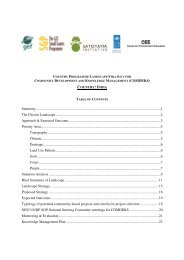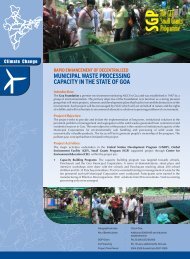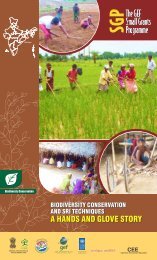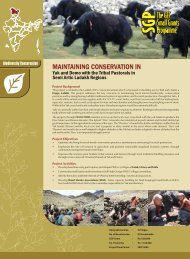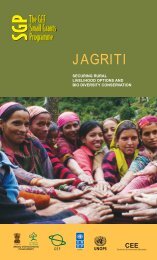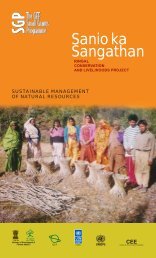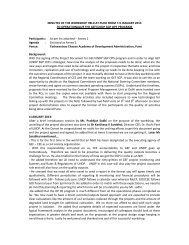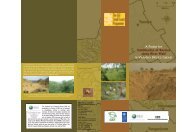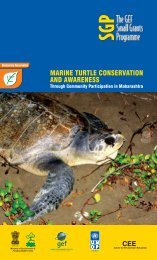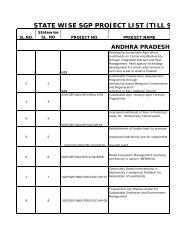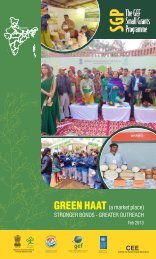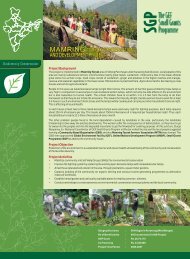DEGRADED LAND MANAGEMENT
Viksat Folder.cdr - SGP India
Viksat Folder.cdr - SGP India
- No tags were found...
Create successful ePaper yourself
Turn your PDF publications into a flip-book with our unique Google optimized e-Paper software.
Gujarat<br />
Land Degradation<br />
Enhancing Livelihood Options<br />
Small and Marginal Farmers through<br />
<strong>DEGRADED</strong> <strong>LAND</strong> <strong>MANAGEMENT</strong><br />
Empowered lives.<br />
Resilient nations.<br />
VIKSAT<br />
Vikram Sarabhai Centre for Development Interaction
Project Villages: Kubda, Vansda & Nana Kothasana of Mehsana District<br />
Classification of Ravine Land<br />
Land Type Villages Total<br />
Nana Vansada Kubda<br />
Kothasana<br />
Gauchar Land (Ha.) 17.46 12.23 27.00 56.69<br />
Revenue Land (Ha.) 0 0 10.37 10.37<br />
Total 17.46 12.23 37.37 67.06<br />
Project Activities<br />
The project through the women based informal SHGs; Tree Growers Co-operatives undertook a<br />
range of simple, east to implement technologies as Bori Bundhs; gully plugs; stone wiers etc.<br />
These measures were successful as they promoted local communities the labour. This small<br />
initiative created greater trust and effectiveness in the program.<br />
Sr.<br />
No.<br />
Activity<br />
Unit<br />
1. Training, Workshops, 7 Trainings, 1 Exposure and,<br />
Exposure visit & 18 Awareness camps.<br />
Awareness Camp<br />
Area<br />
Covered<br />
Mandays<br />
Created<br />
476<br />
About VIKSAT<br />
VIKSAT is an institution of Nehru Foundation<br />
for Development (NFD), a registered public<br />
charitable trust, founded by the eminent<br />
scientist and the legendry visionary, Dr.<br />
Vikram A. Sarabhai, in the year 1966.<br />
VIKSAT, engaged in promotion of<br />
participatory management of natural<br />
resources, believes that the goal of<br />
sustainability in natural resources<br />
development and management can be<br />
achieved only through decisive participation<br />
of the local communities aided by an<br />
enabling role of the government agencies.<br />
At present, VIKSAT has five field offices in<br />
four districts of Gujarat, namely, Bhiloda<br />
taluka, Sabarkantha district (1985); Satlasana<br />
taluka, Mehsana district (1985); Bhuj,<br />
Kachchh district (2001); Santalpur taluka,<br />
Patan district (2003); and Khedbrahma<br />
taluka, Sabarkantha district (2006). This<br />
project was initiated by VIKSAT with<br />
assistance from Global Environment Facility<br />
(GEF) – United Nations Development<br />
Programme (UNDP), Small Grants<br />
Programme (SGP) in 2009.<br />
Name of the Organisation<br />
VIKSAT<br />
Geographical Areas<br />
Nana Kothasana, Kubda &<br />
Vansda villages of Satlasana<br />
Taluka, Mehsana District,<br />
Gujarat State.<br />
No. of Beneficiaries 1627<br />
No. of Female : 750<br />
No. Of Male : 877<br />
SGP Grant ` 1909868<br />
Co-financing<br />
` 11 lacs<br />
Project time period<br />
2009-2012<br />
Project Partners<br />
Local Banks; Gujarat<br />
Agricultural University; Forest<br />
Department and Local<br />
Communities<br />
Project Goal<br />
• Restore Livelihood support systems for poor and marginal farmers in ravine areas with<br />
specific emphasis on poor and women farmer's communities affected by ravine formation.<br />
Project Objectives<br />
•<br />
•<br />
•<br />
Reviving the Ravine Lands and helping village level People's Institutions to manage the<br />
developed ravine land and share the benefits.<br />
Enhancing Knowledge and skills of the people and enhancing ecological balance.<br />
Reducing Desertification and Improving livelihood options.<br />
Project Strategy<br />
The project was implemented with an integrated approach. VIKSAT collaborated with various<br />
departments/agencies like Gram Panchayat, Forest Department and Agriculture University. To<br />
achieve the project goal VIKSAT conducted various Programmes and Trainings of Capacity<br />
Building.<br />
Three Local village level existing institutions in the nature of Tree Grower's Cooperative<br />
societies were strengthened by helping them secure tenure over the land in the form of long<br />
term lease with emphasis on the principle of universal membership and the inclusion of<br />
women and marginalized sections.<br />
2. Trench excavation in 7607 cu.mt. 56.69 Ha 2576<br />
sloppy land<br />
3. Bunding along the 1229.23 cu.mt. 44.46 Ha 442<br />
trenches in the<br />
sloppy lands<br />
4. Earthen bunding 2036.66 cu.mt. (47 bunds) 27 Ha 950<br />
5. Pitching on Earthen 12,550 bags 27 Ha 427<br />
bund<br />
6. Bori Bundh<br />
69 Boribundhs<br />
42616 bags used<br />
56.69 1435<br />
7. Plantation – Grasses 468 Kg 56.69 183<br />
Village<br />
Variety<br />
Dhaman Karad Hamata<br />
Vansda 47 40 10<br />
Kubda 91 65 10<br />
Nana 100 75 30<br />
Kothasana<br />
Total 238 180 50<br />
8. Plantation – Trees 35415 plants and 100 kg<br />
Jhetropha seed<br />
86.69 894<br />
9. Plantation – Nursery 20000 plants (4 Nurseries) 200<br />
10. Horticultural Plants 300 Mango plants 114<br />
distribution<br />
Farmers<br />
11. Watering caring &<br />
maintenance of trees<br />
(soil working,<br />
weeding etc)<br />
49716 plants<br />
3480 mt. social fencing<br />
37.37 900<br />
Project Beneficiaries<br />
The immediate beneficiaries of the project are small and marginal farmers with a land holding of<br />
an average of 1-1.5 ha of dry land. These communities have first time involved in addressing<br />
land development actions as they being mostly migrants, could not stay back to do the land<br />
development actions.<br />
398<br />
Total 8881<br />
Sr.No Village Household Population Total<br />
SC<br />
OBC<br />
Male Female Male Female<br />
1. Nana<br />
Kothasana<br />
320 33 30 580 564 1207<br />
2. Kubda<br />
150 0 0 367 326 693<br />
3. Vansda<br />
115 24 27 245 241 537<br />
Total<br />
585 57 57 1192 1131 2437
4. Grasses Plantations<br />
In 3 villages nearly 850 households (HHs) have taken to fodder plantations. The grasses<br />
plantation have been done in "Seed Pellets". This is a way of distributing and protecting the<br />
seeds by encasing then in a mixture of day, compost and water. The mixture is rolled into dry<br />
balls and then left to dry in sun later these balls are dropped in the gnlly plugs, earthen bunds<br />
and trenches.<br />
First Year<br />
Sr.<br />
No.<br />
1.<br />
2.<br />
3.<br />
Name of<br />
Local Spices<br />
Dhaman<br />
Karad<br />
Hamata<br />
HHs<br />
220<br />
Fodder Harvested (in kg)<br />
1st Cutting 2nd Cutting 3rd Cutting<br />
15,3000 15,1000 90,000<br />
Total Cutting<br />
/ year (kg)<br />
39,4000<br />
Second Year<br />
Sr.<br />
No.<br />
1.<br />
2.<br />
3.<br />
Name of<br />
Local Spices<br />
Dhaman<br />
Karad<br />
Hamata<br />
HHs<br />
350<br />
Fodder Harvested (in kg)<br />
1st Cutting 2nd Cutting 3rd Cutting<br />
21,0000 21,0000 16,0000<br />
Total Cutting<br />
/ year (kg)<br />
58,0000<br />
Project Achievements<br />
1. Capacity Building of Institution-Tree Growers<br />
Co-operative Society (TGCs)<br />
All the decisions have been jointly taken for field<br />
based actions by VIKSAT with local communities<br />
in village meetings. Proper plans were made on<br />
the revenue maps; with clear individual<br />
indicators of actions to be undertaken. This<br />
process enabled the awareness; Skills up<br />
gradation of the local communities. Critical<br />
reflections led to conscious raising of their own<br />
conditions and resources. Problems were<br />
defined and agreed in village meetings.<br />
2. Water table increase<br />
This was a valve learner partiation and nearly at<br />
90% places in the wells, the water has been<br />
increased by 2/3 feet. The expansion of ravines is<br />
now controlled. Increased moisture in down<br />
strewed agriculture has been felt by all farmers.<br />
3. Community Benefits<br />
A total of 8881 mandays were generated in the<br />
project villages. During the project<br />
implementation period employment was<br />
generated for the people of the project village<br />
and as a result they were able to purchase the<br />
seeds in time for the agriculture.<br />
Successful convergence was made with various<br />
stakeholders ie. Gujarat Land Development<br />
Corporation, Mahatma Gandhi National Rural<br />
Employment Guarantee Scheme, National<br />
Agricultural Innovation Project, and Panchayati<br />
Raj Institutions.<br />
Third Year<br />
Sr.<br />
No.<br />
1.<br />
2.<br />
Name of<br />
Local Spices<br />
Dhaman<br />
Karad<br />
Cattle Increase<br />
With the introduction of grasses, in more than 50%<br />
Households (HHs) their had been increase in cattle.<br />
Most of the locals have taken loans from local banks<br />
and through personal investments, benefitted from<br />
mills production.<br />
Lessons<br />
Construction of bore well and hand pump as water<br />
source for plantations was not done which was an<br />
important feature. Therefore in near future this would<br />
be undertaken.<br />
Successful convergence with various depoistments has<br />
helped the program in many ways. Forest department,<br />
Gram Panchyat Kubada; College of Agro foresting all<br />
supported with seeds; good plant materials to establish<br />
the robust programs.<br />
The project adopted "fauilitor approach" rather than<br />
"teacher centred approach". This approach built<br />
greater respect and trust in communities and provided<br />
more local opportunities. The local communicators<br />
adopted by VIKSAT were socially committed; cultural<br />
sensitive empathetic in inter personal interactions and<br />
demo cratic in communication and relationships.<br />
VIKSAT<br />
Vikram Sarabhai Centre for Development Interaction<br />
Mr. Dilip Surkar, Director<br />
Nehru Foundation for Development<br />
Thaltej Tekra, Ahmedabad – 380054<br />
Gujarat<br />
HHs<br />
280<br />
Fodder Harvested (in kg)<br />
1st Cutting 2nd Cutting 3rd Cutting<br />
19,0000 12,0000 80,000<br />
Regional Co-ordinator<br />
Centre for Environment Education<br />
Nehru Foundation for Development,<br />
Thaltej Tekra, Ahmedabad - 380 054<br />
Tel: 079 - 6858002 - 09<br />
Fax: 079 - 6858010<br />
Email: sgpwest@ceeindia.org<br />
Colours 9810037571/SGP/February/13<br />
Total Cutting<br />
/ year (kg)<br />
39,0000<br />
Text: Mr. Prabhjot Sodhi & Vijay Kaushal<br />
National Co-ordinator<br />
GEF UNDP Small Grants Programme<br />
Centre for Environment Education<br />
C-40 South Extension-II, New Delhi-110049,<br />
Ph.: 011-26262878-80<br />
Email: prabhjot.sodhi@ceeindia.org<br />
Website: www.sgpindia.org,www.ceeindia.org



